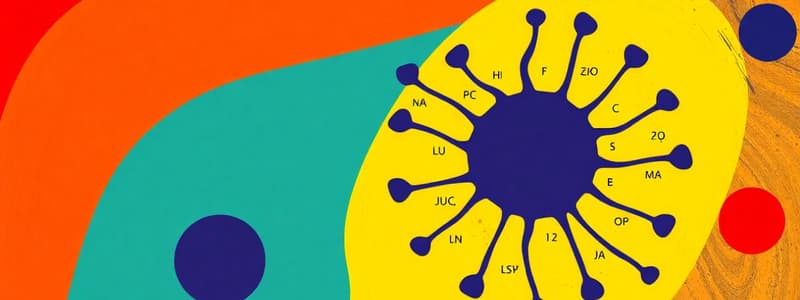Podcast
Questions and Answers
Which group of microorganisms does NOT include any cellular organisms?
Which group of microorganisms does NOT include any cellular organisms?
- Eukaryotes
- Prokaryotes
- Acellular Infectious Agents (correct)
- Algae
What is the primary characteristic of the binomial naming system developed by Carl Linnaeus?
What is the primary characteristic of the binomial naming system developed by Carl Linnaeus?
- It consists of two lowercase words.
- It incorporates a three-part naming structure.
- It includes a single word that combines genus and species.
- It features a two-part system with the first part capitalized. (correct)
When formatting scientific names in online documents, how should they be styled?
When formatting scientific names in online documents, how should they be styled?
- With bold typeface to emphasize the name.
- With an underline to highlight species.
- In italics to distinguish the names. (correct)
- In regular font without special formatting.
Which of the following is an example of a eukaryotic microorganism?
Which of the following is an example of a eukaryotic microorganism?
What is the role of the first part of a binomial name?
What is the role of the first part of a binomial name?
Which of the following examples of scientific names is formatted correctly for handwritten documents?
Which of the following examples of scientific names is formatted correctly for handwritten documents?
Which of the following individuals contributed to the development of the scientific naming system for organisms?
Which of the following individuals contributed to the development of the scientific naming system for organisms?
Which type of bond forms when atoms share pairs of electrons?
Which type of bond forms when atoms share pairs of electrons?
What type of particles are formed when an atom loses an electron?
What type of particles are formed when an atom loses an electron?
How many hydrogen bonds can a single water molecule form with other water molecules?
How many hydrogen bonds can a single water molecule form with other water molecules?
What is a characteristic of ionic bonds?
What is a characteristic of ionic bonds?
Why does ice float on water?
Why does ice float on water?
What was the primary contribution of Robert Hooke to the field of microbiology?
What was the primary contribution of Robert Hooke to the field of microbiology?
Antonie van Leeuwenhoek is best known for which of the following?
Antonie van Leeuwenhoek is best known for which of the following?
Which statement correctly reflects the theory of spontaneous generation?
Which statement correctly reflects the theory of spontaneous generation?
How did Louis Pasteur contribute to the understanding of alcohol production?
How did Louis Pasteur contribute to the understanding of alcohol production?
What was the prevailing belief concerning disease before the germ theory was established?
What was the prevailing belief concerning disease before the germ theory was established?
Pasteurization is primarily used to achieve which of the following?
Pasteurization is primarily used to achieve which of the following?
What technique did Louis Pasteur use to disprove spontaneous generation?
What technique did Louis Pasteur use to disprove spontaneous generation?
Fermentation, as explained by Pasteur, occurs under which of the following conditions?
Fermentation, as explained by Pasteur, occurs under which of the following conditions?
What was the first antimicrobial medication used to treat syphilis?
What was the first antimicrobial medication used to treat syphilis?
Which organism is known for producing penicillin?
Which organism is known for producing penicillin?
What process is responsible for flavor development in chocolate?
What process is responsible for flavor development in chocolate?
What is the capability of Ralstonia eutropha in biotechnology?
What is the capability of Ralstonia eutropha in biotechnology?
Which bacterium can break down trinitrotoluene (TNT) in contaminated soil?
Which bacterium can break down trinitrotoluene (TNT) in contaminated soil?
What type of enzyme is used from Thermomonospora sp. for biofinishing denim?
What type of enzyme is used from Thermomonospora sp. for biofinishing denim?
What aspect of penicillin is significant in medicine?
What aspect of penicillin is significant in medicine?
Which microbe is involved in the fermentation process of cacao seeds?
Which microbe is involved in the fermentation process of cacao seeds?
Which method is considered more environmentally friendly for denim treatment?
Which method is considered more environmentally friendly for denim treatment?
What principle did Edward Jenner's work on smallpox vaccination establish?
What principle did Edward Jenner's work on smallpox vaccination establish?
What did Robert Koch demonstrate through his work on anthrax?
What did Robert Koch demonstrate through his work on anthrax?
What was the key contribution of Joseph Lister to modern surgery?
What was the key contribution of Joseph Lister to modern surgery?
What concept is associated with Paul Ehrlich's research?
What concept is associated with Paul Ehrlich's research?
Which statement best describes Germ Theory of Disease?
Which statement best describes Germ Theory of Disease?
Which of the following represents Koch's postulates?
Which of the following represents Koch's postulates?
Which of the following was NOT a direct result of Pasteur’s findings?
Which of the following was NOT a direct result of Pasteur’s findings?
What was one of the main outcomes of Robert Koch's research methodology?
What was one of the main outcomes of Robert Koch's research methodology?
Which advancement is primarily attributed to Edward Jenner?
Which advancement is primarily attributed to Edward Jenner?
Flashcards
What is Microbiology?
What is Microbiology?
The study of microscopic organisms, including bacteria, viruses, fungi, and protozoa.
What are Prokaryotes?
What are Prokaryotes?
Prokaryotic organisms lacking a nucleus and other membrane-bound organelles. They are typically unicellular.
What are Eukaryotes?
What are Eukaryotes?
Organisms with a true nucleus and membrane-bound organelles, including fungi, algae, and protozoa.
What are Acellular Infectious Agents?
What are Acellular Infectious Agents?
Signup and view all the flashcards
What is the Binomial System?
What is the Binomial System?
Signup and view all the flashcards
What is the Genus?
What is the Genus?
Signup and view all the flashcards
What is the Species?
What is the Species?
Signup and view all the flashcards
Cell Theory
Cell Theory
Signup and view all the flashcards
Robert Hooke's Discovery
Robert Hooke's Discovery
Signup and view all the flashcards
Antonie van Leeuwenhoek
Antonie van Leeuwenhoek
Signup and view all the flashcards
Spontaneous Generation
Spontaneous Generation
Signup and view all the flashcards
Biogenesis
Biogenesis
Signup and view all the flashcards
Louis Pasteur
Louis Pasteur
Signup and view all the flashcards
Pasteurization
Pasteurization
Signup and view all the flashcards
Yeast
Yeast
Signup and view all the flashcards
Anaerobic
Anaerobic
Signup and view all the flashcards
What is an atom?
What is an atom?
Signup and view all the flashcards
What is an element?
What is an element?
Signup and view all the flashcards
What is a molecule?
What is a molecule?
Signup and view all the flashcards
What is the nucleus of an atom?
What is the nucleus of an atom?
Signup and view all the flashcards
What are electrons?
What are electrons?
Signup and view all the flashcards
Germ Theory of Disease
Germ Theory of Disease
Signup and view all the flashcards
Disinfectant
Disinfectant
Signup and view all the flashcards
Antiseptic
Antiseptic
Signup and view all the flashcards
Koch's Postulates
Koch's Postulates
Signup and view all the flashcards
Selective Toxicity
Selective Toxicity
Signup and view all the flashcards
Vaccination
Vaccination
Signup and view all the flashcards
Cowpox
Cowpox
Signup and view all the flashcards
Smallpox
Smallpox
Signup and view all the flashcards
Robert Koch
Robert Koch
Signup and view all the flashcards
Edward Jenner
Edward Jenner
Signup and view all the flashcards
What is an antibiotic?
What is an antibiotic?
Signup and view all the flashcards
What was the first antibiotic discovered?
What was the first antibiotic discovered?
Signup and view all the flashcards
How do microbes break down TNT?
How do microbes break down TNT?
Signup and view all the flashcards
What role do microbes play in making chocolate?
What role do microbes play in making chocolate?
Signup and view all the flashcards
How can microbes make plastics?
How can microbes make plastics?
Signup and view all the flashcards
How do microbes help in biofinishing jeans?
How do microbes help in biofinishing jeans?
Signup and view all the flashcards
Study Notes
Microbiology
- Microbiology is the study of the microbial world.
Major Groups of Microorganisms
- Three groups of microorganisms: Prokaryotes, Eukaryotes, and Acellular Infectious Agents
Characteristics of Microorganisms
-
Prokaryotes:
- Cell type: Prokaryotic
- Number of cells: Unicellular
- Membrane-bound organelles: No
- Ribosomal RNA sequences: Unique to the group
- Peptidoglycan in cell wall: Yes (in bacteria)
- Typical size range: 0.3–2 μm
-
Archaea:
- Cell type: Prokaryotic
- Number of cells: Unicellular
- Membrane-bound organelles: No
- Ribosomal RNA sequences: Unique to the group
- Peptidoglycan in cell wall: No
- Typical size range: 0.3–2 μm
-
Eukarya:
- Cell type: Eukaryotic
- Number of cells: Unicellular or Multicellular
- Membrane-bound organelles: Yes
- Ribosomal RNA sequences: Unique to the group
- Peptidoglycan in cell wall: No
- Typical size range: 5–50 μm
Scientific Names
- Developed by Carl Linnaeus (1700s)
- Latin style, reflects a characteristic or honors a scientist
- Structure:
- 2-part naming system (Binomial system)
- Part 1 = Genus (capitalize the first letter)
- Part 2 = species (all lowercase)
- Formatting:
- Online formats – use italics
- Handwritten formats – underline
- Abbreviate after first use to include only the first letter of the Genus
History of Microbiology
-
Key figures and events in microbiology history
- Robert Hooke (1665): Observed cells
- Antonie van Leeuwenhoek (1674): Observed microorganisms
-
Spontaneous generation vs. Biogenesis
- Spontaneous generation: belief that life can arise from nonliving matter
- Biogenesis: living matter arises only from pre-existing living matter
- Louis Pasteur (1861): Disproved spontaneous generation
-
Germ Theory of Disease
- Microorganisms cause certain diseases
- Joseph Lister (1860s): Used phenol to reduce surgical wound infections
- Robert Koch (1876): Claimed that specific microbes cause definite diseases demonstrated with anthrax and Koch's postulates
- Edward Jenner (1796): Developed a vaccine against smallpox
- Paul Ehrlich (1909): Noticed dyes that stained bacteria differently, proposed the concept of selective toxicity developed salvarsam to treat syphilis
- Alexander Fleming (1928): Discovered penicillin
Other interesting facts about microorganisms
- Microbes can make vitamins
- Microbes can make antibiotics
- Microbes can make chocolate
- Microbes can degrade explosives
- Microbes can make plastics
- Microbes can be used for biofinishing jeans
- Microbes convert atmospheric nitrogen
- Microbes degrade pollutants
- Microbes can make food, cement and insecticides
- Microbes are an essential component of a healthy human
- Microbes play important roles in research
- Microbes can be harmful (pathogens)
Microscopy
-
Light microscope: Uses visible light to observe specimens
-
Compound light microscope: Uses two lenses to magnify the image
-
Objective lens: Lens closest to the specimen. Magnifies between 4x to 100x
-
Ocular lens: The eyepiece. Magnifies by 10x
-
Resolution: ability to distinguish fine detail and structure. The shortest the wavelength the better
-
Electron microscope: Uses electrons instead of light. Resolution power is greater
-
Transmission electron microscope (TEM): Used to see internal structures.
-
Scanning electron microscope (SEM): Used to see surfaces.
-
Atomic force microscope (AFM): Used to see molecules.
Microbiology stains
- Simple stains: use only one dye
- Differential stains: react differently with different bacteria (Gram stain). Gram positives retain the stain (purple), Gram negatives do not (pink)
- Acid-fast Stain: detects the presence of wax compounds in cell walls, typically used for Mycobacterium (e.g. tuberculosis)
- Capsule stain: detects a thick polysaccharide layer; bacteria with a capsule retain the dye and appear colorless.
Cell structure (prokaryotes)
-
Prokaryotes (e.g., bacteria, archaea): DNA is not enclosed in a nucleus.
-
Eukaryotes: (e.g., fungi, protozoa, algae, plants, animals): DNA is enclosed in a nucleus, contains specialized organelles.
-
Bacteria:
- Shape: Coccus, Bacillus, Vibrio, Spirillum, Spirochete
- External structures: Capsules, slime layers, flagella, fimbriae, pili
- Internal structures: Cytoplasm, nucleoid (contains DNA), ribosomes, storage granules, endospores
-
Cell wall Structure and roles
- Peptidoglycan (in bacteria): a complex macromolecule that forms a mesh-like structure, important for bacterial shape and preventing cell rupture, and used in differentiating bacteria via the Gram stain.
- Gram-positive cell walls: Thick peptidoglycan layer, teichoic acids, cytoplasmic membrane
- Gram-negative cell walls: Thin peptidoglycan layer, outer membrane, lipopolysaccharide (LPS), cytoplasmic membrane
-
Cell Structure (Eukaryotes)*
-
Cytoplasm: The substance inside the plasma membrane of eukaryotes.
-
Cytoskeleton: made of protein filaments that give a cell shape, structure, and aids in the transport of substances.
-
Ribosomes: Sites of protein synthesis, larger and heavier (80S) than prokaryotic ribosomes.
-
Nucleoid: Contains the bacterial chromosome, which has all the genetic information for cell functions; may also have plasmids.
-
Endospores: Special resting structures that allow some Gram-positive bacteria to enter a dormant state.
-
Flagella, Cilia: Appendages that enable movement and transporting substances.
-
Membrane-Bound Organelles: Nucleus, Mitochondria, Chloroplasts, Golgi Apparatus, Peroxisomes, Lysosomes
Studying That Suits You
Use AI to generate personalized quizzes and flashcards to suit your learning preferences.




